
- Topics 1531
- Industrial 59
- Troubleshooting Guides 31
- Restaurant Management 140
- Bar Management 66
- Catering Tips 38
- Bakery Management 47
- Food Trucks & Concessions 47
- Advertising & Marketing 40
- Eco-Friendly Tips 12
- Facility Layout & Design 50
- Coffee Shop Tips 31
- Installation & Maintenance 59
- Janitorial & Pest Control 35
- Safety & Sanitation 110
- Startup Tips 113
- Menu Design 11
- Kitchen & Cooking Tips 104
- Hospitality Management 24
- Pizza & Sandwich Shop Tips 30
- Smallwares 40
- Food Prep 101
- Tabletop Items 19
- Disposables 26
- Calculators & Tools 8
- Consumables 70
- Warewashing & Laundry 21
- Cooking Equipment 101
- Food Storage & Refrigeration 54
- Beverage Equipment 39
- Office Supplies 5
Piping tips are essential tools for bakers seeking to elevate their creations with precision and artistry. With a variety of shapes and sizes available, these tips allow for intricate designs, smooth lines, and beautiful decorations on cakes, cupcakes, and cookies. Whether you're a pastry chef or a hobbyist, understanding the different types of piping tips and their applications can help you achieve stunning results in your baked goods.
Shop All Piping Tips
Use the following links to learn more about piping tips:
- Plain Piping Tips
- Leaf Piping Tips
- Drop Flower Piping Tips
- Flower Piping Tips
- Petal Piping Tips
- Grass Piping Tips
- Ruffle Piping Tips
- Basketweave Piping Tips
- Open Star Piping Tips
- Closed Star Piping Tips
- Swirl Piping Tips
- St. Honore Piping Tips
- Russian Piping Tips
- Cake Icers
- Bismark Piping Tips
- Pastry Tip Sizes
- Types of Couplers
- How to Clean Piping Tips
Different Types of Piping Tips
When it comes to decorating cakes and pastries, choosing the right piping tip is crucial for achieving the desired design and texture. There are various types of piping tips available, each serving a unique purpose, making them an excellent gift for bakers. Piping tips are also classified into different families based on the size and shape of their openings, often sold in piping tip sets. We created a list of the most common piping and icing tips that you can choose from:

Plain piping tips feature a round or oval opening that allows for the creation of clean, smooth lines and shapes on cakes, cupcakes, and cookies. The round opening of plain piping tips is ideal for outlining designs, writing messages, creating borders, and piping simple decorations with precision and ease. The wider styles of plain piping tips are perfect for delivering dollops and swirls of delicious types of frosting onto cupcakes. With their straightforward design, plain piping tips are a must-have for any commercial bakery or pastry kitchen looking to achieve professional-looking results.
- Shape Created: Smooth lines, frosting dollops
- Use: Outlining details, writing, adding dots, filling in flower centers, and completing complicated lattice and lacework
- Common Numbers: #0 - #9
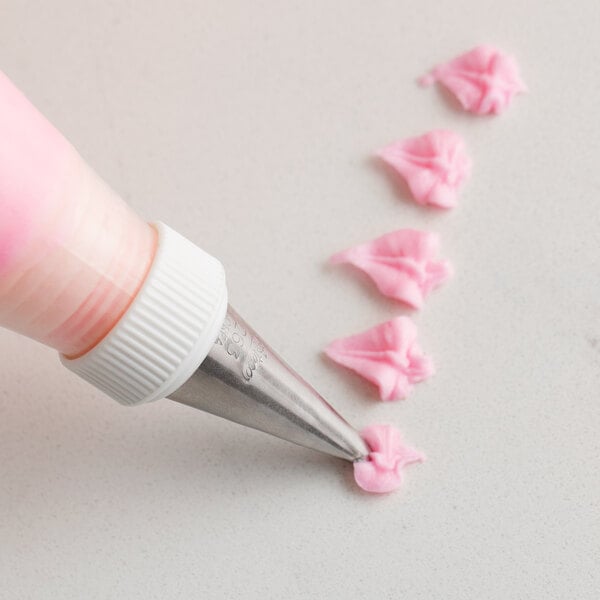
Leaf piping tips are used to create intricate and lifelike leaf designs on baked goods. These tips are specially designed with a narrow, pointed shape that allows decorators to pipe out detailed petal and leaf shapes with ease. Leaf piping tips come in various sizes, each producing different leaf shapes and sizes. Larger tips are ideal for creating bold and prominent leaves and petals, while smaller tips are perfect for delicate and fine details. By varying the pressure and angle of the piping bag, decorators can create different textures and patterns, adding depth and dimension to their designs.
- Shape Created: Plain, ruffled, or stand-up leaves
- Use: Floral-themed cakes, nature-inspired designs, seasonal decorations, and borders and accents
- Common Numbers: #65 - #76, #112 - #115 #349, #350, #352, #353, #363
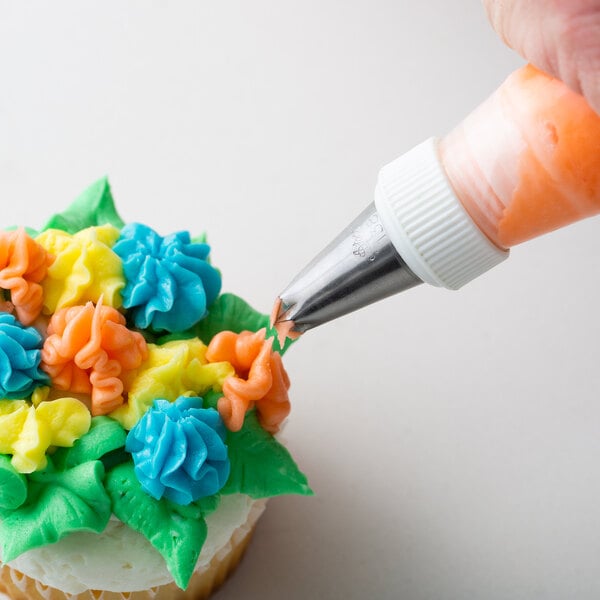
Drop flower piping tips are a popular choice among bakers and decorators for creating intricate floral designs on cakes and cupcakes. These tips are characterized by their unique shape, which allows for the easy piping of delicate flower petals with a single squeeze of the piping bag. By simply applying consistent pressure to the piping bag, users can create elegant flower designs in a variety of sizes and styles. Larger tips are perfect for creating bold, eye-catching flowers, while smaller tips are ideal for delicate floral arrangements or intricate details. Drop flower piping tips are essential for those looking to cater weddings.
- Shape Created: Arranged flowers (the number of cuts on the tip determines the number of petals on the flower)
- Use: Making one-squeeze flower accents and floral borders for wedding and birthday cakes and seasonal cupcakes
- Common Numbers: #106, #107, #108, #129, #131, #135 #171
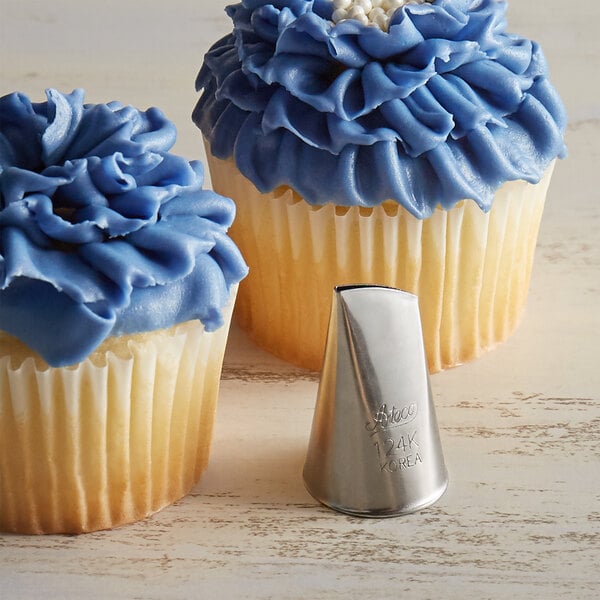
Flower piping tips are a popular choice among bakers and cake decorators for creating intricate floral designs on desserts. These piping tips are specially designed to mimic the delicate shapes and textures of various flowers, allowing for stunning and realistic decorations. Two common types of flower piping tips are the rose piping tip and the chrysanthemum piping tip. These flower piping tips can be used to create beautiful intricate flowers with just a few simple motions. By applying pressure to the piping bag and moving it in a circular motion, bakers can create layered petals that resemble the natural beauty of roses and chrysanthemums. This tip is perfect for adding a touch of elegance to wedding cakes, birthday cakes, and other special occasions.
- Shape Created: Flower petals for specific types of flowers like roses and chrysanthemums
- Use: Making roses, ruffled flowers, and cake borders on floral-themed desserts and pastries
- Common Numbers: #101, #102, #103, #104, #127, #143, #227
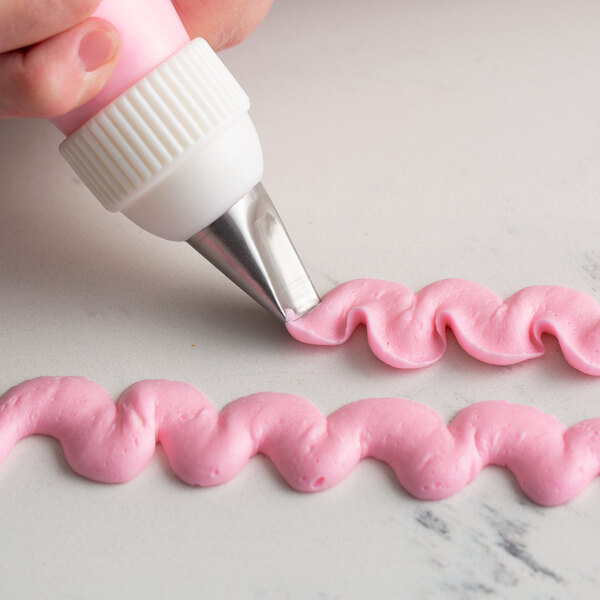
Petal piping tips are specifically designed to create intricate flower petals and borders on cakes, cupcakes, and other baked goods. Their unique shape and size allow for precise control over the flow of icing or frosting, making them ideal for adding delicate details to your creations. When using petal piping tips, bakers can easily achieve lifelike flower designs by layering overlapping petals in various colors. These tips are also perfect for creating curved decorations such as scrolls, swirls, and waves, adding a touch of elegance to your desserts. Petal piping tips can be used to create decorative borders around the edges of cakes, cupcakes, and cookies, enhancing the overall presentation of the baked goods.
- Shape Created: Curved design
- Use: Designing flower petals, curved decorations, swirls, and borders
- Common Numbers: #59, #60, #61, #120, #121, #122, #123
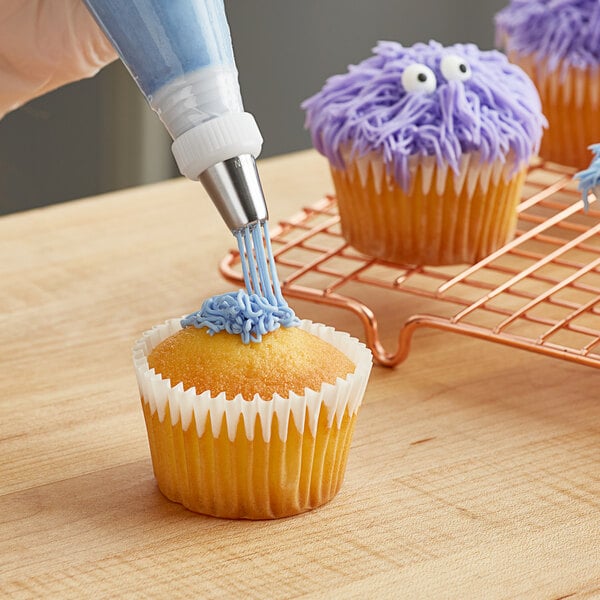
Grass piping tips are a popular choice for creating textured designs on baked goods. These tips are known for their multiple small holes that release icing in a grass-like pattern, making them perfect for creating realistic grass, fur, or foliage effects. The smaller tips are ideal for fine, delicate grass patterns, while larger tips can produce a more bold and defined look. Whether you're decorating a birthday cake or seasonal cupcakes for a special event, grass piping tips offer a unique and eye-catching way to add texture and dimension to your desserts.
- Shape Created: Small uniform cylindrical strands
- Use: Adding grass, noodle, and fur patterns to decorate whimsical or seasonal desserts
- Common Numbers: #133, #233, #234

Ruffle piping tips are characterized by their scalloped edge, which creates a beautiful ruffled effect when piping buttercream or icing onto cakes and cupcakes. Ruffle piping tips come in various sizes, allowing for different levels of ruffle intensity and design flexibility. When using ruffle piping tips, decorators can create stunning borders, floral accents, and decorative patterns on baked goods. The ruffled texture adds depth and dimension to the design, making the finished product visually appealing and eye-catching.
- Shape Created: Smooth or ridged ribbons of icing
- Use: Creating ribbons, ruffles, swags, bows, scallops, and edges
- Common Numbers: #030, #040, #050, #070, #86, #88, #100
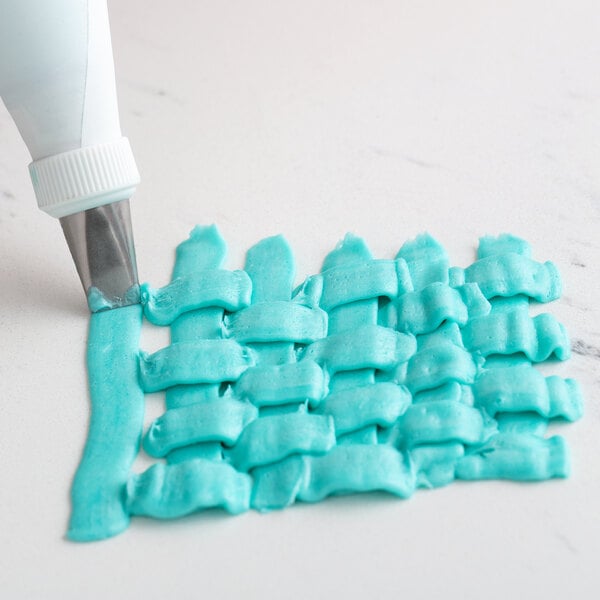
Basketweave piping tips feature a unique design that allows bakers to achieve a woven or basket-like pattern on the surface of their creations. Basketweave piping tips are commonly used to create borders, accents, and even entire designs on cakes, as well as more intricate designs such as latticework and braided patterns. They are available in various sizes, allowing for different textures and patterns to be created. A frosting with medium to stiff consistency is typically recommended for creating crisp and defined designs with basketweave tips.
- Shape Created: Smooth or ridged flat frosting lines
- Use: Adding basketweave, lattice lines, and braiding along the border or over the whole surface of a cake
- Common Numbers: #44, #45, #46, #47, #48, #895, #897, #898
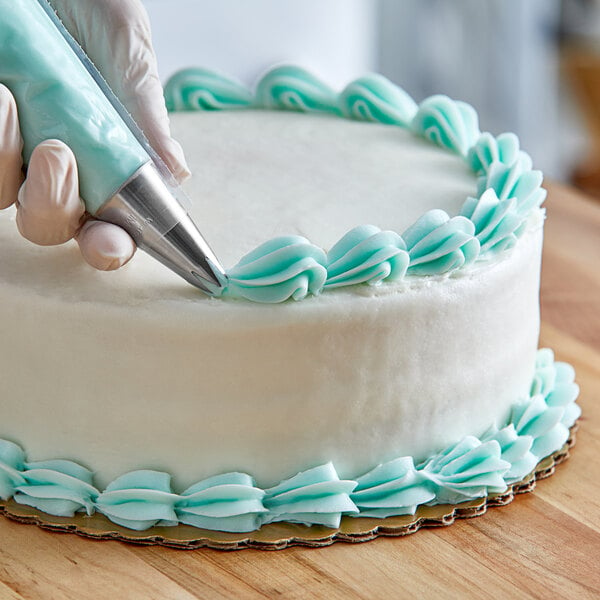
Open star piping tips have a series of cutouts around the tip that flare upward, creating ridges in the frosting. They are a popular choice among bakers and pastry chefs for creating beautiful and intricate designs, including stars, rosettes, and shells. The open star design produces textures on the frosting, adding visual appeal to the finished product. Larger tips are ideal for creating bold, eye-catching designs, while smaller tips are perfect for intricate details and fine piping work. When using open star piping tips, it is important to hold the tip slightly above the surface of the baked good and apply even pressure to create consistent lines and shapes.
- Shape Created: Slightly ridged round lines
- Use: Adding shells, stars, rosettes, swirls, and textured borders to baked goods
- Common Numbers: #13 - #22, #32, #199, #363, # 826, #828

Closed star piping tips are popular for their pattern of small indentations that form a closed star shape when the icing is piped out. The indentations in the tip curve inward, helping the icing hold its shape and produce a three-dimensional effect. They are commonly used to create stunning borders, rosettes, flowers, stars, and other intricate decorations on cakes, cupcakes, and cookies. Whether you are looking to add small, delicate details to your desserts or create bold and eye-catching designs, closed star piping tips offer the flexibility to cater to your specific needs.
- Shape Created: Deeply ridged cylindrical lines
- Use: Frosting cupcakes and designing stars, fleurs-de-lis, and flowers
- Common Numbers: #23 - #31, #840 - #850

Swirl top piping tips have prongs that curve inward in one direction to produce its signature ridged swirl when piped. These tips are ideal for adding a decorative edge to the top or bottom of a cake, as well as for outlining designs and patterns on the surface of the confection. They are also perfect for creating beautiful individual swirls and rosettes to dollop on top of wedding cakes, birthday cakes, and cupcakes. When using swirl top piping tips for borders and outlines, it is important to maintain a steady hand and consistent pressure to achieve clean and even lines.
- Shape Created: Swirling cylindrical lines or dollops
- Use: Producing textured borders and outlines on cakes, cookies, and cupcakes
- Common Numbers: #96, #885, #886, #887, #888
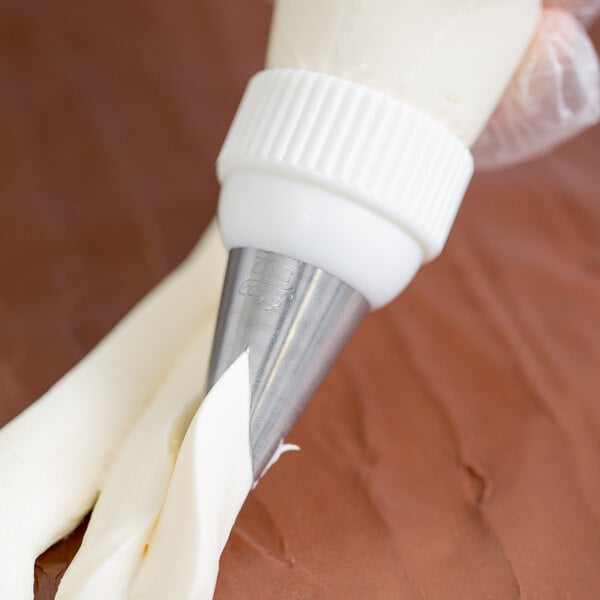
St. Honore piping tips are named after the classic French pastry, St. Honore cake, known for its delicate and beautiful decorations. These tips are mostly round with the exception of a V-cut out at the top of the tube, which creates a teardrop-shaped cross section. This icing style is used on the top and between the pastry puffs on the St. Honore cake. It can be used to create striking and elegant single-ridged frosting lines on cakes and cupcakes for eye-catching final results.
- Shape Created: Teardrop-shaped lines of frosting
- Use: Creating St. Honore cakes and thick frosting lines on pastries
- Common Numbers: #880, #881, #882, #883

Russian piping tips are a popular choice among pastry chefs due to their intricate designs. These tips are larger than traditional piping tips and feature a more extensive opening, allowing for the easy and quick creation of elaborate designs on desserts. Russian piping tips are known for their versatility, enabling users to effortlessly pipe flowers, roses, and other intricate designs with just a single squeeze. These tips are perfect for adding a touch of elegance and sophistication to baked goods, eliminating the need for intricate and prolonged piping techniques. They are excellent for design uniformity, making them a favorite among both novice and experienced bakers.
- Shape Created: Intricate designs and patterns in a single squeeze
- Use: Adding delicate and unique flowers to cakes and cupcakes
- Common Numbers: #241 - #249, #270 - #275

Cake icers are a versatile type of piping tip, designed to help bakers quickly and efficiently cover the surface of a cake with a smooth and even layer of icing. Cake icers are typically large in size and feature a wide flat or ridged opening that allows for the easy application of frosting or icing a cake. They are great for creating clean, professional-looking finishes. This makes them ideal for creating beautifully decorated cakes for special events or high-volume production settings. When using a cake icer, it is important to hold the piping bag at a consistent angle to ensure an even layer of icing is applied.
- Shape Created: Broad and flat strips of icing
- Use: Quickly icing the tops and sides of cakes
- Common Numbers: #789, #790
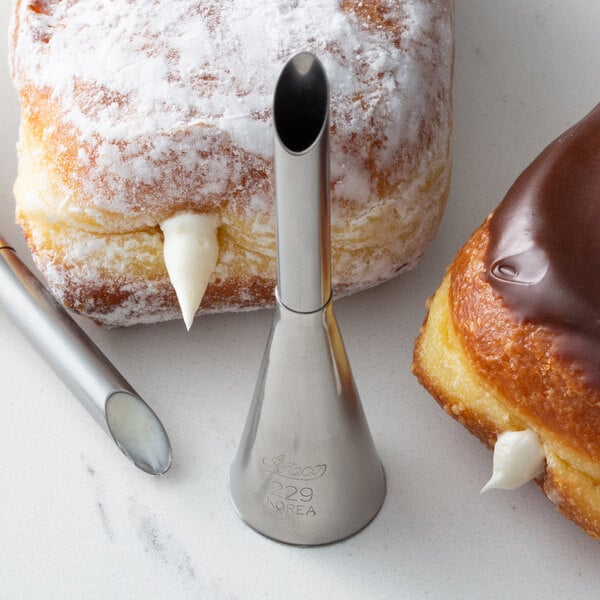
Bismark piping tips have a long, narrow opening that allows for filling pastries, cupcakes, and cakes with creams and custards. Their elongated shape makes it simple to insert the tip into the center of pastries and release the filling smoothly. This results in perfectly filled treats that not only look professional but also taste exquisite. They are commonly used to create filled donuts, eclairs, cream puffs, and other decadent treats. Smaller Bismark tips are perfect for filling mini cupcakes or small pastries, while larger tips are ideal for injecting generous amounts of filling into larger desserts. Whether you're looking to add a burst of fruit jam, a dollop of fluffy cream, or a rich chocolate ganache, Bismark piping tips are the go-to choice for achieving uniform and appetizing results.
- Shape Created: Pools of filling in desserts
- Use: Filling donuts, cream puffs, and other pastries
- Common Numbers: #229, #230, #231
Decorating tips are assigned different numbers based on the shape and size of their openings. Below is a graphic that shows some of the most common pastry tip numbers and what the result of using them is.
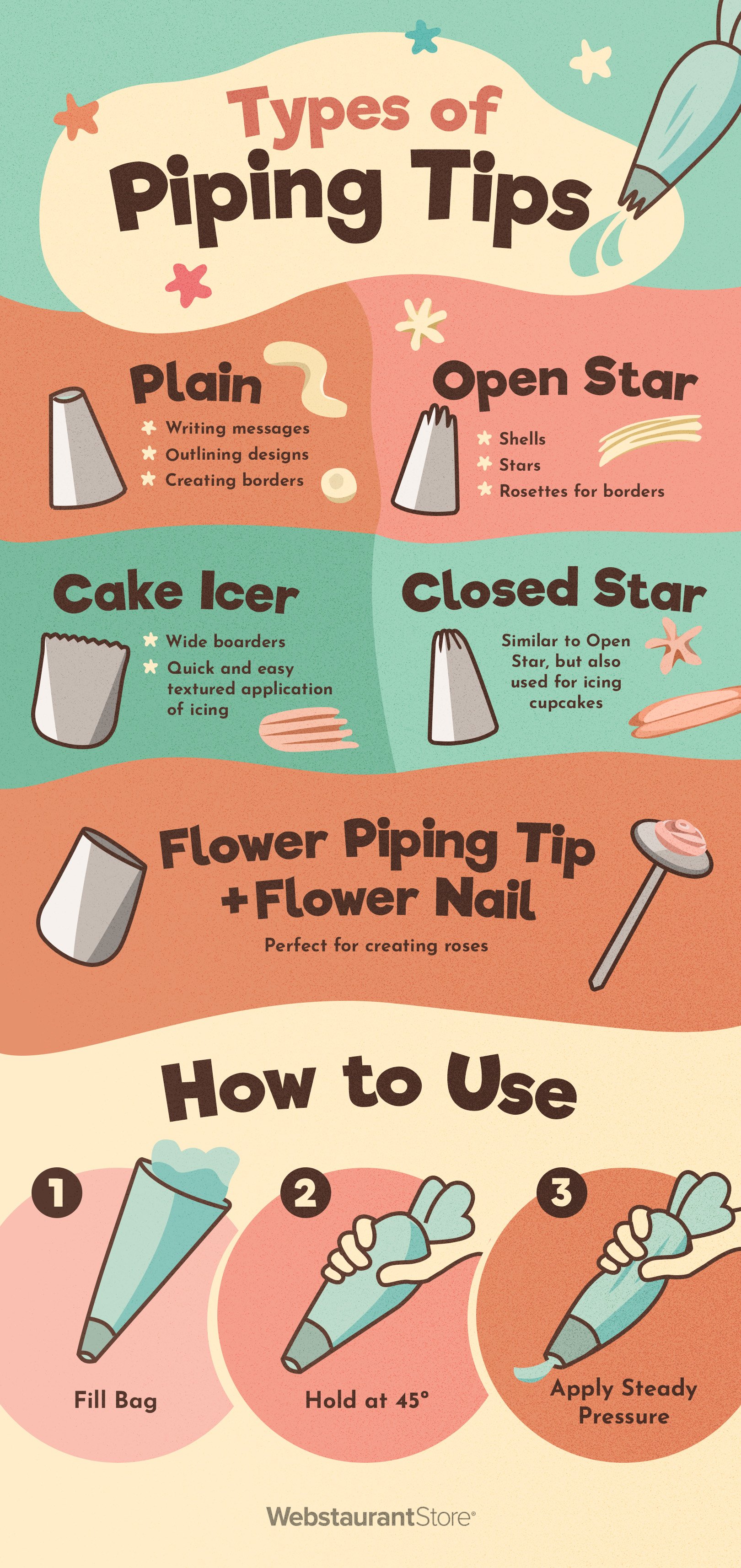

Make your piping process more efficient with couplers. These tools allow you to quickly switch between tip styles without having to change bags and refill your icing or pastry dough. With an array of sizes available, you can be sure to find a coupler that fits the bag and tip you need to use.
- 7-Piece Plastic Coupler: These couplers allow you to interchange any small, medium, or large-sized piping tips. A 7-piece plastic coupler works best with pastry tips that have a bottom diameter of 1/2" to 1 1/2".
- 2-Piece Standard Plastic Coupler: A 2-piece coupler allows you to interchange small/standard-sized piping tips. They work best with piping tips that have an 11/16" bottom diameter.
- 2-Piece Large Plastic Coupler: 2-piece large plastic couplers are for large-sized piping tips that have more than a 3/4" bottom diameter.
- 3-Piece Medium Plastic Coupler: The 3-piece medium couplers are for medium piping tips that have a 3/4" bottom diameter.
How to Use a Coupler
Using a coupler with your piping tips can save you time and effort when decorating cakes, cupcakes, cookies, and more. Here's a step-by-step guide on how to use a coupler effectively:
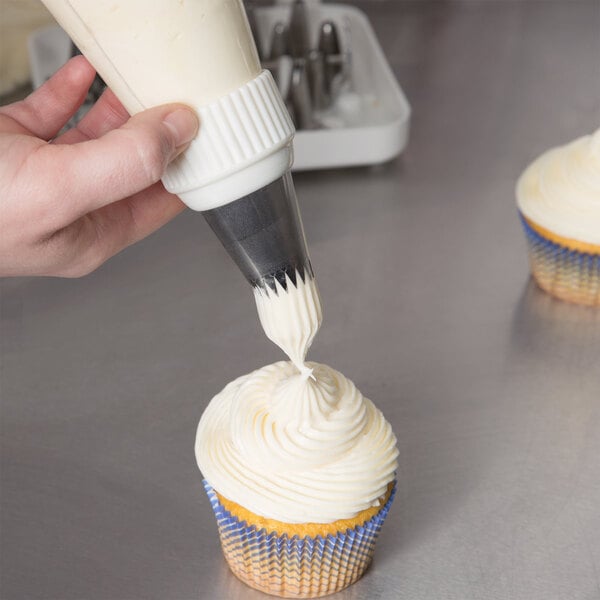
Choose Your Piping Tip: Start by selecting the piping tip you want to use for your decoration. Place the larger piece of the coupler inside your piping bag, with the threaded end sticking out of the bag.
Cut the Bag: Cut the tip of your piping bag to fit the size of the piping tip you are using. Make sure to cut the hole just large enough for the tip to fit through snugly.
Insert Piping Tip Into Coupler: Slide the piping tip onto the threaded end of the coupler that is sticking out of the bag. Secure the tip in place by twisting on the coupler ring over the tip.
Add the Icing: Fill your piping bag with your desired icing or frosting. Make sure not to overfill the bag, as this can make it difficult to control the flow of icing later on.
Close the Bag: Twist the open end of the piping bag to push the icing down towards the coupler and tip. Gently squeeze the bag until the icing starts to flow out of the tip.
Cleaning piping tips is an essential part of maintaining their performance and hygiene in a commercial kitchen. Follow these steps to effectively clean your piping tips:
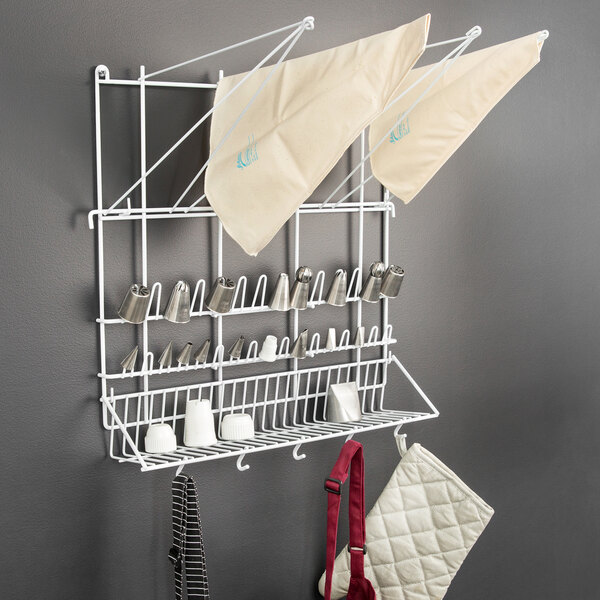
Disassemble the Piping Tips: Before cleaning, disassemble the piping tips from the piping bags or couplers. Make sure to remove any leftover icing or frosting inside the tips.
Rinse with Warm Soapy Water: Fill a sink or a container with warm soapy water. Place the piping tips in the water and let them soak for a few minutes. Use a brush or a sponge to gently scrub the tips, ensuring all residue is removed.
Use a Cleaning Brush: For stubborn residue or clogs, use a specialized cleaning brush designed for piping tips. Insert the brush into the tip and gently scrub to dislodge any dried icing or frosting.
Rinse Thoroughly: After cleaning, rinse the piping tips under running water to remove any soap residue. Ensure that all soap is washed away to prevent any unwanted flavors in your next batch of icing.
Sanitize the Piping Tips: To further ensure cleanliness, sanitize the piping tips by soaking them in a sanitizing solution for the sanitizer's recommended time. This step helps kill any remaining bacteria or germs.
Air Dry: Allow the piping tips to air dry completely before storing them. Placing them on a clean towel or drying rack will help them dry faster and prevent any moisture buildup that can lead to rust.
Related Resources

January 2025 WebstaurantStore Coupon Code
The holiday season is over, and to ring in the new year and combat the post-holiday blues, you can find amazing deals on important items here at WebstaurantStore all January long! From essential coffee service equipment to ingredients and supplies for your favorite winter recipes, we have a slew of great deals to warm you up this cold season! Check out our selection of sale items below and don't forget to enter the code FROSTY26 at checkout to enjoy 10% off your purchases! Looking to save even more? Check out the new Webstaurant Rewards® Visa Business Card ! Sign up for a new card today and start earning rewards on every WebstaurantStore purchase, and save on a WebstaurantPlus subscription. Explore incredible deals on winter disposable item
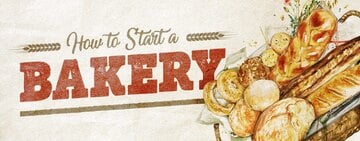
How to Start a Bakery
Whether you dream of opening a donut shop or a boulangerie, starting a bakery allows you to serve niche markets and express culinary creativity without taking on the financial burden of opening a restaurant. You can even start your bakery business from home before investing in a commercial space. While bakeries are comparatively accessible foodservice businesses, they present unique challenges. From writing a bakery business plan to getting funding and filing for permits, we walk you through each step of opening a bakery. Shop All Bakery Supplies Jump to a specific step of opening a bakery: Choose Your Bakery Style Write a Bakery Business Plan Get Startup Loans Lease a Bakery Location Bakery Permits and Licenses Order Bakery Equipment Desig
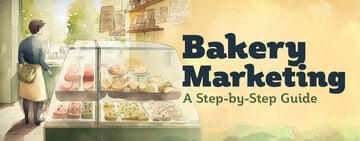
Bakery Marketing Strategies
To make your new bakery successful, it's important to define your target market and put an actionable plan in place to reach them. Developing a well-researched bakery marketing plan allows you to pick a location for your business in the heart of your ideal customer base and create content that resonates with them. Not just important for reaching customers, you must include market research and a bakery market analysis in your business plan to show future investors that your business has the potential for success. We've created a step-by-step guide to marketing your bakery so you can reach your sales goals. Use these links to skip to the bakery marketing information that interests you: Market Research Write a Market Analysis Set Marketing Goa

